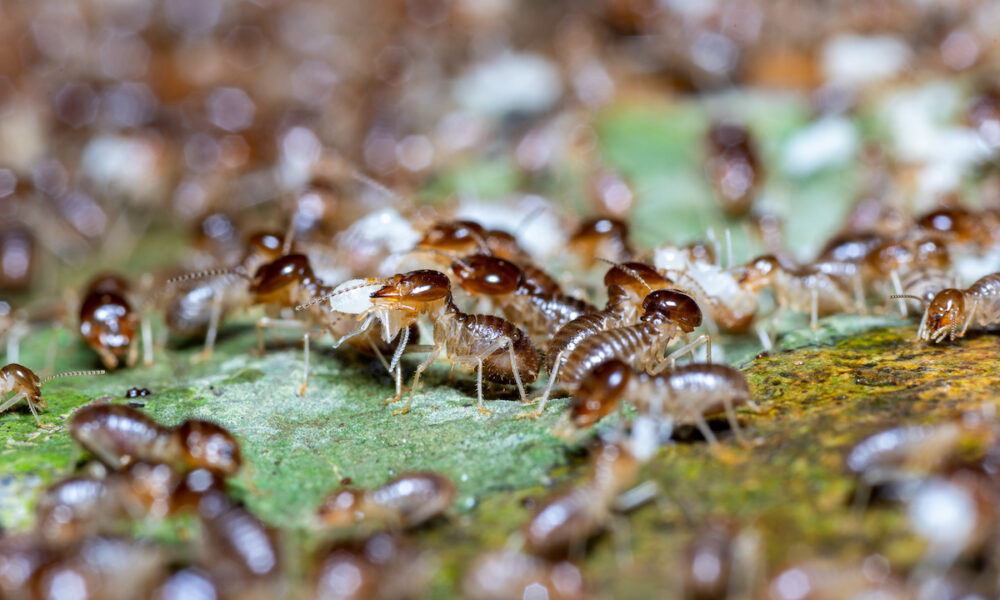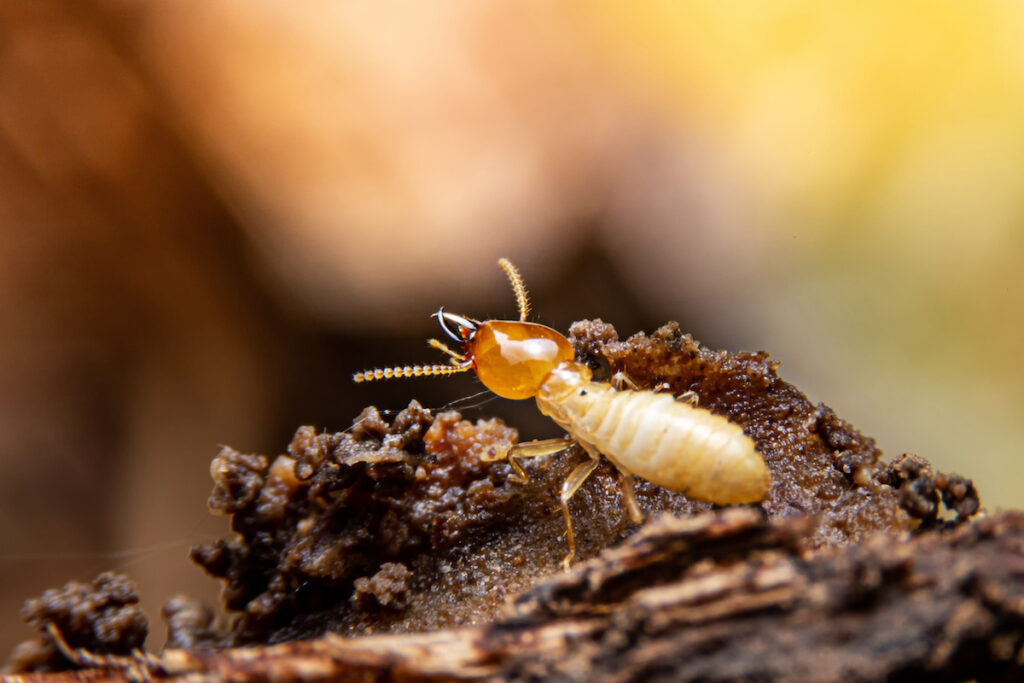
Did you know that termites are the most active during the spring season? The first day of spring is March 20, which is just around the corner. While we all look forward to watching for rising temperatures and blooming flowers, unfortunately, we also need to watch for signs of termite infestation.
What causes higher termite activity at this time of year?
Warm, sunny weather gets all of us moving- including termites. As the temperature rises, you are more likely to see termite swarmers, small air-borne termites, flying around to seek out mates and start new colonies.
Termites can pose a devastating risk to your home, so it’s important to understand how to identify signs of termites and what to do if you suspect an infestation in your home.
Termite Infestation Signs: Identifying Termites
First, let’s talk about what termites look like and what types of termites you might encounter. In the US, there are 45 different kinds of termite species. Each termite species falls into 1 of 3 categories: Subterranean, Drywood, or Dampwood.
Subterranean Termites
Subterranean termites, also known as “hardwood termites”, are the most common type of termite nationwide. They live in the soil and build the largest nests of any insect in the US. They have a caste system similar to ants and bees and use odor trails, rather than pheromones, to communicate.
Large subterranean termite colonies may be hidden underground and difficult to find, so often the only evidence of their existence is the wood damage they leave behind.
Drywood Termites
Drywood termites are common in southern coastal states such as Georgia. They form smaller colonies so they are less aggressive than other types of termites, but they can spend years gnawing away at your home before you even realize they are there.
They are commonly found in older homes that have chipping or peeling exteriors. Drywood termites live in dead trees or the wood framing of structures, but you may also find them in structural timbers such as floor joists. They need very little moisture and don’t require a connection to a soil source like Subterranean termites.
Dampwood Termites
Dampwood termites are rare in Georgia. You are unlikely to find them in your home or other man-made structures because they require wood with a much higher moisture content. Unlike most other termites, Dampwood termites don’t eat wood. Rather they feed on the organic matter found in the wood, similar to wood-boring beetles. They have a symbiotic relationship with a certain type of fungus, which aids in digesting the cellulose material that the termite cannot digest on its own.
What Does a Termite Look Like?
It’s important to understand what termites look like so that you can distinguish them from other pests in your home.
Termites are small, about the size of an ant. Their colors vary, but they typically have brown or tan bodies and dark heads. They feature a double set of wings but only swarmer termites can fly, and only during certain times of the year. Worker termites and queens typically stay inside the colony, creating tunnels and hatching eggs.
Termites vs. Flying Ants: What’s the Difference?
Termites and flying ants have a similar appearance, so it’s easy to get them confused with one another. What is the difference between termites and flying ants? How do you tell which is which?
There are three families of flying ants: Myrmecia, Paraponera, and Platythyrea. All of these ants are similiar to the more common household ants and are found in the same regions of the US.
Flying ants have larger wings than termites with long bent antennae. Termites have a broader body while ants have a narrow waist. At first glance, it can be difficult to tell the difference, so if you are unsure whether you have flying ants or termites it’s best to play it safe and consult with an exterminator before the damage begins.
Do Termites Bite?
It’s unnerving enough to come across a termite infestation at your home, but what if a termite bites you? While some types of soldier termites are technically capable of biting humans, they very rarely act aggressively toward them.
In most cases, a termite is harmless to you and your pets, but your home is certainly at risk.

Termite Infestation Signs
Hopefully, you never need to worry about a termite infestation, but it’s important to be aware of the signs.
At first, termite infestations are pretty hard to detect, which is one of the reasons they can do so much damage before you even realize they are in your home. Termites eat wood very slowly, which means you may have none of the mess you would find with a mouse or other pest. A quality pest control service can identify a termite infestation before the average homeowner notices a problem.
Some of the signs of a termite infestation include:
1. You see swarmers.
Termites are social insects that live in colonies within a structure. While these colonies come with hundreds of thousands of termites, most never leave the nest.
Swarmers, the reproductive members of the colony, can seek out mates and new colony locations in the early spring and summer. They like light so watch for signs of swarmers, such as wing and body fragments around your doors and windows. Swarming termites have two pairs of large pale wings and are easier to spot than most other insects because they are constantly in the air.
2. Your windows and doors are sticking.
Are you suddenly having trouble opening and closing your doors? While this might just be a sign that they need to be replaced, this could also be a sign of a termite infestation. Termites are attracted to the exposed wood around windows and door frames so this is often where damage will first be evident to the untrained eye.
Other possible signs of structural termite damage include crumbling baseboards, warped or bucking floorboards, and sagging ceilings.
3. You find mud tubes.
Subterranean worker termites use their saliva, combined with soil and wood fragments to construct mud tubes, which are long narrow dirt tunnels running from the soil to areas of exposed wood. These tubes protect the termites from the dry air ensuring they have safe passage from their colony to their food source. Once constructed, these tunnels are filled with wood fragments, feces, and trail pheromones to confuse other termites.
If you think you spot a mud tube around your property break it open to inspect for live termites. If you come back later and find the tube has been reconstructed, you can be sure that you have a current infestation.
4. Your paint or wallpaper is warping and bubbling.
Termites create tunnels within your walls to feed on the wood underneath. Sometimes you can see the wall bulging but usually, the damage is covered by paint and wallpaper. It’s important to look carefully for evidence, especially when doing renovations or repairs.
Watch for areas of paint that are bubbling or sunken or wallpaper that is peeling or it has an odd coloring. Sometimes you may be able to spot tiny pinholes where termites burrow into the wall.
5. You discover droppings.
Subterranean and Dampwood termites rarely leave droppings, known as “frass” because they use them to construct their tunnels. However, Drywood termites, which are common here in Georgia, push their frass outside of the colony to prevent buildup. Drywood termite frass resembles a small pile of wood shavings, but upon closer inspection, you will see that they are compact and in the shape of a pellet. Look for frass around windows, doors, or anywhere else that has exposed wood.
Do You Have Termite Infestation Signs? Contact Houseman Services Now
As spring approaches termites will become more active and easier to spot. Now that you know the signs of a termite infestation what should you do if you find swarmers, mud tunnels, or frass in your home?
By the time a typical homeowner discovers termites in their home, they’re already facing an average of $3,000 in repairs. So it’s important to contact a professional exterminator right away to get rid of these insects before they cause extensive damage and irreplaceable loss to your home.
Don’t wait, call Houseman Services, the go-to termite exterminator in Georgia at the first sign of termite activity in your home. Contact us today for help!